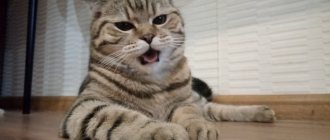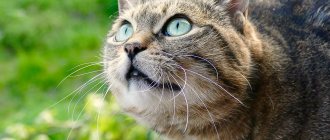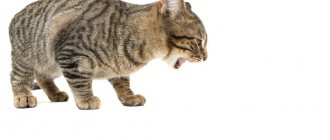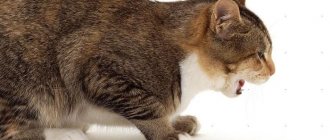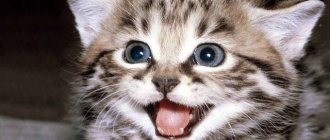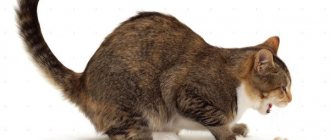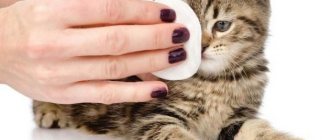- Why does yellow vomit occur in cats?
- Symptoms that indicate you need to take your cat to the vet
- Treatment of bile vomiting in a cat
As you know, vomiting in a cat can be a completely natural process of self-cleansing of the stomach, or it can occur against the background of various diseases of the gastrointestinal tract, biliary tract, liver, and the like. Vomit can tell a lot about the nature of vomiting and the reasons for the development of this condition. By the color and presence of impurities in the vomited contents of the pet’s stomach, the owner can assess how pathological the process is, why it occurred and whether the animal needs immediate consultation with a veterinarian.
What does each discharge indicate when vomiting occurs?
If your pet has vomited a couple of times at most and is feeling quite normal, there is no need to panic. This can be caused by intestinal irritation, which occurs due to swallowing fur or a large clump of grass. In this case, it is recommended to monitor the pet’s condition for one day and then look for the reasons for the deterioration of its health.
The cat may vomit bile, as indicated by the yellow color, and may also suffer from other discharges. Regular vomiting of a rich yellow or green hue primarily indicates that there are problems in the functioning of the liver or kidneys. There may also be stomach problems.
Blood present in the vomit may indicate that the esophagus or pharynx has been damaged by some sharp object, such as a fish bone.
Causes of nausea and vomiting in cats
Burping fur is a physiological process of getting rid of external irritants and should not be a cause for concern. But if this happens regularly, you should contact a specialist who will determine the cause of this condition.
The main reasons why a pet may vomit:
- In Siamese cats, underdevelopment of the posterior wall of the stomach (pylorus) is common. Because of this, “fountain” vomiting occurs. In this case, only surgery helps.
- Pregnancy can also cause nausea and vomiting due to changes in the body and hormonal imbalance.
- Vomiting often accompanies ear diseases in cats.
- Disturbances in the liver (pancreatitis, lipidosis) or pathologies associated with the kidneys can cause yellow vomiting in the cat.
- Nausea is also accompanied by pathologies such as stomach or pancreatic cancer.
- Intestinal obstruction.
- Parasites that poison the pet’s body from the inside.
- Stress (moving, a long trip in transport can cause motion sickness in a cat and, accordingly, vomiting).
Vomiting, its causes and dangers
Vomiting is a complex protective process based on reflexes, with the help of which the cat’s body gets rid of dangerous and harmful substances. Vomiting is usually the main symptom of gastrointestinal problems.
Let us immediately note that an attack of vomiting, occurring once every 3-4 days, is the norm, especially in cats. However, there are still specific reasons. To understand them, you need to analyze the cat’s diet, and perhaps make it starve for a while. Most often, cats vomit from overeating - they simply eat too much and too quickly. This applies to both dry food and natural food, but dry pieces are very easy to regurgitate, especially if they are poorly chewed. Most often, those animals that regurgitate are those that live in conditions of competition for food and therefore absorb food quickly and greedily. By the way, some of them will not disdain to eat the food removed from the body again.
Animals that live together tend to eat quickly and chew their food poorly, so regurgitation is common for them.
If a domestic cat often regurgitates food as soon as it leaves its bowl, then it is overeating or this type of food is of poor quality. Economy-class food, such as Felix, Whiskas, Sheba and the like, have a poor composition and contain many harmful additives, so such food will clearly not benefit your pet.
It is advisable to purchase premium and super-premium food for your pet, and for chronic diseases - specialized lines of such food
Causes of vomiting in cats
The main causes of vomiting can be divided into two large groups: reflex irritation of the digestive organs and poisoning.
In the first case, foreign substances or excessive amounts of food irritate the organs of the digestive tract and cause a reflex reaction of rejection. The following reasons may lead to this:
- improper diet: too rich, not suitable for cats, poor consistency (sticky, rubbery food, with bones, etc.);
- ingestion of a large amount of hair when licking (especially in long-haired cats): hairballs cause mechanical irritation of the stomach and also interfere with the normal excretion of feces from the body, which also contributes to vomiting;
- parasites that mechanically irritate the liver and intestines;
- chronic diseases of the gastrointestinal tract;
- ingestion of foreign bodies - small toys, hair bands, threads, waste from a garbage can;
- seasickness - vomiting due to disturbances in the functioning of the vestibular apparatus.
In the second case, poisoning occurs with toxic substances that enter the blood, spread throughout the body, irritate the vomiting center in the brain and cause vomiting. Intoxication may have the following origins:
- waste products of intestinal parasites - kittens are especially sensitive to their effects;
- poor quality, expired food;
- chemicals: detergents, bleach, medications, indoor plants;
- infectious and inflammatory diseases leading to disorders of the gastrointestinal tract;
- chronic kidney diseases, causing general intoxication of the body;
- false pregnancy, which can occur in cats after estrus;
- brain damage: trauma, edema, increased intracranial pressure;
- stress, shock or psychological trauma.
Danger of vomiting
A dangerous consequence of vomiting is dehydration, which quickly occurs with persistent and prolonged vomiting. It is especially poorly tolerated by small kittens. An animal can quickly die from dehydration, so if vomiting does not stop, you should immediately take the animal to a doctor.
With persistent vomiting, even water is not retained in the cat’s body: as soon as the cat drinks, it starts vomiting again
It is also necessary to measure the cat’s temperature: in case of infectious and inflammatory diseases it increases, in case of poisoning and shock it decreases. In both cases, you need to go to the doctor or call him at home.
The temperature in cats is measured in the anus for 2-3 minutes, the norm is a temperature of 38 to 39 degrees
The vomit should not contain blood, mucus, have a strange color or a foul odor - in this case, you should also contact your veterinarian immediately.
Symptoms
The appearance of yellow, foamy vomiting in a cat may be accompanied by other symptoms, which indicates disturbances in the functioning of orgasm. Often there is a refusal to eat, an increase in body temperature, dark urine, diarrhea and yellowing of the mucous membranes.
Vomit with a strong, unpleasant odor may indicate acute or chronic liver failure. With this pathology, yellowing of the sclera, fainting, and an unpleasant odor from the mouth can be observed.
If toxic elements accumulate in the liver for a long time, this ultimately leads to inflammation (lipidosis). There is also such a disease as feline distemper, which is accompanied by a sharp rise in temperature to 41 degrees, apathy, frequent diarrhea and vomiting. At the same time, the cat constantly walks hunched over.
Main reasons
Yellow vomiting in a cat is a pathological condition indicating that the pet has bile in its stomach, which normally should not be there. The liquid negatively affects the state of the digestive organ and irritates it. Sometimes a cat vomits stomach acid and yellow mucus after eating low-quality, color-matched food. This is a common cause of the problem. After removing such foods from the diet, the condition returns to normal, nausea and vomiting cease to bother.
Owners should be concerned if vomiting of bile occurs constantly or periodically. Veterinarians clarify that this condition does not occur on its own. Often it indicates that there is a disease in the body that negatively affects the functioning of internal organs and systems.
If the symptom is provoked by liver failure of the animal, then yellowing of the sclera can also be detected.
The reasons why an animal burps yellow liquid are:
- Helminthiasis. With severe helminthic infestation, the body is poisoned. To get rid of parasites, the cat vomits. If worms have damaged the walls of the stomach and intestines, in addition to bile streaks, brown-red inclusions are found in the vomit.
- Ingestion of a foreign body. If an animal swallows an inedible object, then if it is small in size it will leave the body naturally, along with the feces. Otherwise, the process of bile production is activated, which allows the substance contained in the stomach to be digested. Excess bile irritates the digestive organ, resulting in gag reflexes.
- Liver failure. Vomiting in a cat that is yellow in color and has an unpleasant odor may be a consequence of liver dysfunction. With this pathology, it becomes noticeable that the animal’s sclera has turned yellow.
Other reasons
A kitten or adult cat may vomit a lot of yellowish liquid as the following diseases progress:
Symptoms can appear in animals whose owners independently give them drugs of certain groups.
- plague;
- hepatitis;
- lipidosis;
- disruption of the gallbladder;
- cholecystitis;
- uncontrolled treatment of a cat with self-prescription of antibiotics, glucocorticosteroids, non-steroidal anti-inflammatory drugs.
If your kitten is vomiting white liquid in the morning, it may be due to hunger vomiting. At night the animal does not eat anything, and in the morning unpleasant cramps appear. It is enough to give the cat something to eat, after which the condition will return to normal. A dangerous condition is when a cat vomits bile, but the vomit also contains dark brown or black inclusions. This is a sign of heavy internal bleeding, which can be caused by gastritis or a stomach ulcer. If an animal vomits yellow-green liquid, this may be a symptom of an infectious lesion of the gastrointestinal tract. Sometimes the animal vomits hair where bile impurities are present. This condition does not pose a threat to health and is the norm. It is not uncommon for a pet to burp after sterilization. You should not offer an antiemetic, as vomiting is a protective mechanism to remove the anesthetic from the body.
Yellow vomit
The cause of yellow vomiting in a cat is bile entering the stomach. During normal functioning of organs, it must be excreted through other channels. The appearance of yellow vomit indicates problems with the gallbladder or liver. Bile is a hostile environment for the gastrointestinal tract. If it nevertheless leaks into the stomach, then after a certain time the walls of the organ begin to become inflamed, and this causes yellowish vomiting.
A cat whose vomit is bright and rich yellow could eat food of this shade. And he didn’t suit her. This factor is also worth considering.
Gallstone disease in dogs and cats
D.E. Mitrushkin. Veterinary Clinic “Biocontrol”, Clinic of Experimental Therapy, State Institution Russian Cancer Research Center named after. N.N. Blokhin RAMS
Keywords:
bile, gallstones, cholelithiasis, bile duct, cholelithiasis, gallbladder, cholecystolithiasis, liver, hepatic ducts
Abbreviations:
ALT
- alanine aminotransferase,
CT
- computed tomography,
BC
- breast cancer,
US
- ultrasound,
ALP
- alkaline phosphatase,
ECG
- electrocardiogram
Introduction
Bile is a secretion that is constantly produced in the liver and enters the intrahepatic bile ducts, which, merging, form the right and left extrahepatic ducts, located near the porta hepatis. These ducts unite and form the common hepatic duct, which passes into the common bile duct, which flows into the duodenum. Bile enters the gallbladder (bile storage reservoir) from the common bile duct through the cystic duct and from it, as needed, is released back into the common bile duct.
Gallstone disease (cholelithiasis, from the Greek chole - bile and lithos - stone) is a metabolic disease of the hepatobiliary system, characterized by the formation of gallstones in the gallbladder (cholecystolithiasis), less often in the intrahepatic bile ducts (hepatic cholelithiasis) or the common bile duct (choledocholithiasis) .
Cholelithiasis is a rare disease in dogs and cats. Even its presence in animals is often asymptomatic and before the introduction of ultrasound into veterinary practice, it was often detected only during autopsy. The main reason for the formation of gallstones is a violation of the functional state of the liver (due to hepatitis, hepatosis or cirrhosis) and, in connection with this, a change in the physicochemical properties of bile (dyscholia). The formation of gallstones is associated with impaired metabolism of the main components of bile - cholesterol, phospholipids (lecithin, etc.), bile acids, bile pigments (bilirubin, biliverdin) and inorganic salts. Cholesterol in the bile of healthy animals is retained in a dissolved state due to cholesterol-retaining factors (bile acids and phospholipids). With the above liver pathologies, the amount of these two cholesterol-retaining factors falls below a critical level and favorable conditions are created for the formation of colloidal solutions of cholesterol with the formation of thick heterogeneous bile (the initial or pre-stone stage of cholelithiasis) with further crystallization of cholesterol and the formation of stones. The formation of these stones may also be associated with increased secretion of cholesterol.
Predisposing factors for cholelithiasis include the presence of pathology (stenosis, tumor, adhesions, atrophy, dyskinesia, hypertrophy, etc.) of the biliary tract or gallbladder, leading to stagnation of bile (cholestasis) in both the liver and gallbladder. The entry of microorganisms or trematodes into stagnant bile creates the most favorable conditions for cholelithiasis, because in this case, mucus and dead epithelial cells are added to the stagnant bile. Risk factors for stone formation are also considered obesity, hemolytic anemia, poor feeding, insufficient exercise, hereditary factors, etc. [2, 4, 6, 9, 11, 13].
Stones in the intrahepatic bile ducts in animals and humans are much less common than in the gallbladder or extrahepatic bile ducts. This is due to the fact that bile in the gallbladder is the most concentrated and the tendency to sediment appears in it first. In addition, bile in the intra- and extrahepatic bile ducts is constantly moving (flowing), and in the gallbladder it is at rest for a certain time.
Gallstones differ sharply in composition and appearance. Their chemical composition mainly includes three substances - cholesterol, calcium bilirubinate and calcium carbonate.
There are three main types of gallstones:
- cholesterol stones. They consist mainly of cholesterol. As a rule, solitary, yellowish-white in color, soft consistency. If the stones are in the bubble for a long time, they may become encrusted with calcium salts and become combined;
- pigment stones. They consist of calcium bilirubinate, cholesterol and bile acids. Most common in dogs. They are always multiple, black with a shiny surface, faceted in appearance. Most often of a loose consistency. Their appearance is associated with an excess of bile pigments, formed, in particular, in diseases accompanied by hemolysis;
- combined (cholesterol-pigment-calcareous) stones. They contain all three components in varying proportions, and the color and consistency of the stones depend on the predominance of one of them. Cholesterol gives a yellowish tint, calcium bilirubinate gives a black-brown tint, and calcium carbonate gives a white tint. Combination stones are always multiple. Their surface is usually smooth, irregular in shape, less often rounded. If there are few stones and they are large enough, articular surfaces form between them - slightly concave on one stone and correspondingly convex on the adjacent one.
In the presence of any stones, there is a likelihood of developing acute and chronic calculous cholecystitis, although with cholesterol and pigment stones, inflammatory processes of the gallbladder are rare.
Small gallstones in chronic cholecystitis with dilation of the cystic duct can migrate from the bladder and, depending on their size, slip into the duodenum, get stuck in the cystic duct, common bile duct, or ascend into the hepatic ducts. The stone can act as a valve, obstructing the flow of bile into the duodenum or gallbladder. In the latter case, the bladder first collapses, then the absorption of bile and swelling of the organ wall. If the outflow of bile from the gallbladder is disrupted, the bladder becomes overfilled with bile, blood circulation in it is disrupted as a result of compression of the feeding vessels, and destructive changes develop in the wall of the organ. If there are stones in the ducts, stones are constantly found in the bladder or liver. Isolated choledocholithiasis apparently does not exist. If stones are found in the ducts and there are no stones in the bladder or liver, it can be assumed that all the stones have passed into the ducts [1, 3, 12, 14, 15].
Streamlined bile duct stone may not cause clinical symptoms and morphological changes in the ducts, gallbladder and liver. But more often, the presence of a stone in the duct leads to serious consequences. First of all, the development of mechanical (cholestatic, obstructive, subhepatic) jaundice is possible. With incomplete obstruction, there may be intermittent jaundice, expansion of the overlying parts of the bile ducts and hypertrophy of their walls. Stagnation of bile also extends to the intrahepatic bile ducts; with prolonged obstruction, secondary biliary cirrhosis and cholangitis develop. Complete obstruction of the bile ducts causes the development of the symptom complex of acute obstructive jaundice, which is characterized by cholemic syndrome and acholia syndrome.
Cholemic syndrome develops due to the entry of the main components of bile into the systemic circulation against the background of cholestasis (leading to increased pressure in the overlying bile ducts, stretching and increased permeability of bile capillaries or their rupture). Clinical manifestations of cholemia are jaundice (deposition of bilirubin gives the mucous membranes and sclera a characteristic icteric color), anorexia, vomiting, dehydration, pain on palpation of the right hypochondrium (due to spasm of the smooth muscles of the gallbladder and bile ducts), bradycardia and skin itching (due to increased level of bile acids in the blood). A biochemical blood test reveals high levels of total bilirubin, ALT, alkaline phosphatase and cholesterol; when studying a coagulogram - a decrease in the rate of blood clotting; A clinical blood test may reveal moderate or severe leukocytosis (with a shift to the left) or anemia.
Stopping the flow of bile into the intestines (acholia syndrome) leads to discoloration of feces, steatorrhea, dysbacteriosis and intestinal autointoxication [1, 3, 7, 8, 10, 11, 12].
Description of clinical cases of cholelithiasis
During the first half of 2009, three cases of cholelithiasis were reported among patients at the Biocontrol clinic. In three animals (a Cornish Rex cat, a miniature poodle and a Yorkshire terrier), the owners' complaints during initial treatment were associated with other pathologies (pyometra, convulsive syndrome, breast cancer and cough), and upon examination and further treatment of the underlying disease, a concomitant disease was identified as cholelithiasis . In all three cases, the diagnosis was confirmed by pathological examination.
Clinical case 1.
An 11-year-old Cornish Rex cat was admitted to the clinic with the owners' complaints of purulent discharge from the noose, periodic vomiting of bile and anorexia for 24 hours. An animal diagnosed with pyometra underwent supravaginal ovariohysterectomy. 12 days after the operation, the animal was admitted in extremely serious condition. Body temperature 32.0°C, pale mucous membranes, lethargy, anorexia, vomiting bile, convulsions, hard breathing sounds on auscultation.
Clinical blood test: leukocytes – 32.8 thousand/µl; red blood cells – 7.28 million/µl; hemoglobin – 101 g/l, hematocrit – 35.7%; platelets – 58 thousand/µl.
Biochemical blood test: glucose – 1.98 mmol/l; bilirubin - 9.9 µmol/l; ALT - 599 U/l; AST – 237 U/l; urea - 10.4 mmol/l; creatinine - 190 µmol/l; pancreatic amylase – 1734 U/l.
During an ultrasound, the animal was found to have many hyperechoic inclusions in the liver and gall bladder. On the same day, the cat underwent an exploratory laparotomy, during which the animal underwent cholecystotomy with removal of stones. During the operation, the animal suffered cardiac arrest.
A pathological and anatomical study revealed severe edema and acute inflammation of the liver (Fig. 1); hepatic cholelithiasis (Fig. 2); interstitial nephroso-nephritis; severe fibrosis of the pancreas; myocardial edema; pulmonary atelectasis.
Rice. 1. Microphoto. Histological section of the liver. Severe swelling, leukocyte infiltration. Hematoxylin and eosin staining, vol. ×40, approx. ×10
A
B
IN
G
Rice. 2. Macro photo. Hepatic cholelithiasis. Many combined stones of yellow and dark green color in the intrahepatic bile ducts. The stones are easily “squeezed out” by lightly squeezing the liver, which has a dense consistency (Fig. A, B, C). When cutting a stone, the layered structure and color change are clearly visible (shown by an arrow in Fig. D)
Yellow vomit with foam in a cat
Vomit with foam, regardless of the shade, may indicate such a dangerous disease as feline distemper. Symptoms develop gradually. Vomiting can occur up to 10 times a day, but the cat does not lick itself, looks for places away from bright sunlight and does not react to others.
There is also a complete refusal of food and water, since the animal itself feels great discomfort. If you have such signs, home treatment does not help, you need to seek help from a specialist as early as possible.
Vomiting bile in cats - is it dangerous or not?
It may appear if the cat does not eat for a long time, yellow vomit. In this case, vomit may have a yellow color even with a slight release of bile, which is formed as a result of reverse peristalsis of the duodenum. If these are one-time incidents, they should not cause concern. If your cat vomits frequently, for example, after every meal, you should consult a veterinarian. Only he can say after a comprehensive examination whether these symptoms are dangerous or not.
The specialist will order a general blood and urine test, an x-ray and an ultrasound of the abdominal organs. Questions about the animal’s nutrition are also often asked. Only after this is the cause of the yellow vomit identified and treatment prescribed.
It is worth understanding that a large amount of bile in the stomach may be accompanied by green vomit. This indicates intestinal obstruction and requires urgent medical attention.
Symptoms
Vomiting in a cat that is yellow in color, even once, is a reason to contact a veterinarian, as it is a serious symptom indicating a disruption in the functioning of the body.
You should immediately go to the clinic if your pet experiences repeated vomiting with bile and bloody clots, concentrated with mucus. Such symptoms indicate intestinal volvulus, perforation of the stomach by an ulcerative lesion, or the disintegration of a malignant tumor in the area of the intestinal loops.
In case of fountain vomiting (when it is not possible to leave the house with the animal), it is necessary to call a doctor at home. The younger the animal, the higher the risk of dehydration during prolonged bouts of vomiting.
In addition to the fact that the cat is vomiting bile, other characteristic symptoms may be observed:
- breathing problems;
- profuse diarrhea;
- febrile conditions in the animal;
- coma in a cat;
- swelling in the peritoneum;
- sudden weight loss;
- the cat refuses to drink water and does not eat (symptoms indicate intestinal volvulus).
It is problematic to independently identify the cause of what is happening, and prescribing independent treatment is also dangerous for the animal’s life. Any delay in providing qualified assistance to a cat can cost it its life.
When contacting a veterinary hospital, the veterinarian conducts a general clinical examination and collects a detailed medical history. The medical history must indicate what the animal ate on the eve of vomiting and whether there are any chronic diseases.
In some cases, the doctor may only need a clinical examination and history taking. But in the vast majority of cases, serious examinations are required to make an accurate diagnosis. Accurate diagnosis includes:
- ultrasonography;
- radiography of liver structures, gallbladder and intestinal loops;
- computed tomography for suspected tumor processes;
- endoscopy to exclude inflammation in the stomach and duodenum;
- general blood and urine analysis;
- examination of vomit samples.
Vomiting in a pregnant cat
An animal may burp while carrying kittens, since the body is being rebuilt at this time and a hormonal imbalance occurs. There is nothing wrong with this if it happens in the morning and there are no impurities in the vomit. If the spasms are repeated, the discharge comes with different impurities, you should seek advice.
Perhaps this is the body's natural reaction to pregnancy. In this case, it is worth reconsidering the diet of the expectant mother and sticking to dietary foods. A cause for concern may be a condition when the cat neither eats nor drinks, and the vomit is yellow. Only a doctor will determine how to treat such an ailment after assessing the condition. If diarrhea also appears, you should immediately seek advice from a specialist. With such symptoms, the body of a pregnant cat loses twice as much moisture. Severe dehydration can be fatal.
What does the appearance of vomiting and blood in the stool indicate?
Bloody feces are quite common in cats. Common causes include constipation if your pet eats too much dry food. Prolonged defecation leads to constipation, and hence blood in the stool. In this case, it is worth reviewing the diet, and the pet’s stool will return to normal.
If your cat has yellow vomiting and bloody feces for a long time, you should be wary, as this may indicate a dangerous disease.
This is often how a disease called hematochezia manifests itself. It is accompanied by heavy bleeding in the lower intestine. Many people confuse it with melena, but with this pathology the stool is black. Hematochezia is accompanied by apathy of the pet; he refuses food and water, and also often runs to the toilet. If you have these signs, you should immediately contact your veterinarian.
Causes of blood in stool
Often, the reasons that lead to the appearance of blood in the stool are associated with disorders of the gastrointestinal tract.
Disorders that are accompanied by the appearance of feces containing blood in a cat:
- peptic ulcer;
- poisoning;
- malignant or benign neoplasms;
- kidney dystrophy, pancreatitis;
- allergic reaction;
- eating disorders;
- foreign body in the stomach.
These diseases require treatment under the supervision of a veterinarian. If constipation is treated by switching to a dietary diet, then some pathologies cannot be eliminated without medication or surgery.
There are also a number of diseases in which blood may appear in the stool.
- Melena or tarry stools. The pathology is accompanied by bleeding that occurs in the lower intestine. It can be caused by an ulcer or damage to the digestive tract. Other signs also appear: she refuses to eat, behaves apathetically, hunches over, and vomits.
- Colitis. The disease can be accompanied by both constipation and diarrhea, and yellow vomiting. The cat neither eats nor drinks. What to do with such a pathology? Contact a specialist immediately.
- Toxic infections. When poisoned with hemolytic poisons, the animal hides in a dark corner, often vomits, refuses to eat and behaves apathetically. He may experience an increase in body temperature.
- Helminthiases. Accompanied by copious and frequent vomit (including worms), stomach upset (constipation or diarrhea), mucous membranes become yellow, conjunctivitis appears, and breathing is heavy. At the same time, the cat also experiences a decrease in the amount of hair and weight loss.
All these pathologies require timely therapy, since its absence can lead to the development of peritonitis, anemia and even death.
Diagnosis of the animal's condition
Even the most competent specialist is unable to make a correct diagnosis based solely on the clinical picture of the disease. For this purpose, the animal is prescribed a series of studies. First of all, a general and biochemical blood test is performed.
Problems with the liver and gall bladder will be indicated by an increased level of bilirubin (above 7.9 µm/l), high levels of alkaline phosphatase, and cholesterol. There is an increase in the level of bile acids, glutamate dehydrogenase, and transaminases. Leukocytosis is also detected.
An informative method for diagnosing diseases of internal organs, including the gallbladder, is ultrasound diagnostics. During the examination, thickening of the wall of the diseased organ is detected, its echogenicity increases. In the gallbladder, processes of inflammation, hyperplasia of the mucous membrane, and heterogeneity of bile in the organ are observed.
Ultrasound for acute cholecystitis in a cat
If indicated, the animal may undergo a fine-needle biopsy for the purpose of cytological and bacteriological examination of bile. High-tech veterinary clinics also perform scintigraphy of the diseased organ. X-ray examination methods are not so informative and are rarely used in veterinary practice when diagnosing cholecystitis.
To learn what tests a cat should do to make a diagnosis, watch this video:
First aid
A veterinarian is involved in finding the causes and treating vomiting in a yellow cat. But what if you have to travel far to get there? How to provide first aid to your beloved pet? To begin with, it is worth eliminating the development of dehydration, which can occur with excessive vomiting or diarrhea. You need to force the cat to drink as much as possible. Give a small amount of water every half hour. It is also worth not feeding the animal, but putting it on a fasting regime for at least 24 hours.
It is not recommended to give your pet antiemetic medications that are intended for use on your own. If the vomiting does not stop for more than a day, you should contact a veterinarian to eliminate the causes. But before that, you can only alleviate the unpleasant symptoms. Especially when the cat has diarrhea, yellow vomit, and neither eats nor drinks.
What to do and how to alleviate the animal’s condition:
- if the vomit contains lumps of hair or food that has not been digested by the stomach, it is worth holding off on feeding for now; you can only give water;
- with frequent belching, which is somewhat similar to vomiting, it is worth reviewing the diet, namely, removing canned food, sweets and fatty foods;
- Chamomile decoction will help restore peristalsis and normalize the functioning of the gastrointestinal tract (1 tsp is given up to four times every morning).
This first aid can help if the pet does not have serious problems with the liver, gall bladder or other pathologies of internal organs.
What to do
If you vomit once, even if it was yellow liquid with foam, you don’t need to do anything. It is necessary to monitor the animal so as not to miss a repeat episode.
First aid for an animal
If the animal ate a lot of food before vomiting, especially when it is new, this may be a reaction of the body to the components. Therefore, first of all, you should not let the cat eat for several hours (up to 24 hours). This will allow the body to independently digest all the nutrients, as well as excrete them in the form of feces.
To prevent dehydration, be sure to give the animal clean water or chamomile decoction. The liquid should be given a few milliliters once every 15-30 minutes. The liquid will dilute the aggressive bile in the stomach and will not become a provoking factor for vomiting.
Gastric contents will irritate the mucous membrane less, which will reduce the urge to vomit and reduce the likelihood of developing an inflammatory process in the future.
When should you take your pet to the vet?
Your pet should be taken to the veterinarian if it is vomiting frequently, not eating, or the condition persists for more than 24 hours, or if other symptoms get worse. This indicates complications that are dangerous to the life and health of the animal.
What to pay special attention to when treating an animal
Do not give your pet medications intended for humans. This can further worsen the animal's condition.
Treatment of a cat should be carried out under the supervision of a veterinarian after a complete examination (blood test, ultrasound of the abdominal organs, x-ray). First of all, it is necessary to establish the factors that provoked the development of the disease and take measures to eliminate them.
It is necessary to provide the animal with adequate care: dietary nutrition, complete rest. As prescribed by the doctor, give the cat medications (for helminthic infestation - anthelmintics, for poisoning - detoxification therapy).
When to seek help from a veterinarian?
What should I do if my cat has yellow vomit, he doesn’t eat or drink, and these symptoms have lasted for more than a day? If even with first aid your pet’s condition does not improve, you should consult a specialist. You should also consult a veterinarian if the following signs appear: diarrhea, lethargy and apathy, and increased body temperature.
All this indicates that the animal is unwell. In this case, only a veterinarian can identify the causes of the pathology and prescribe the correct therapy.
What treatment is prescribed?
The pet must be shown to a specialist if the owner did not help him on his own.
If your cat is vomiting bile and the condition does not improve after first aid, you should urgently take your pet to the doctor. After an initial examination and medical history, the doctor will give a direction for a series of diagnostic procedures that will help find out why the cat is burping. When the diagnosis becomes known, a comprehensive treatment regimen is prescribed aimed at eliminating the original source of the problem.
Sorbents will help remove toxins from the body, and to prevent the cat from vomiting again, antispasmodics and antiemetics are prescribed. During therapy, food intake should be limited; it is better if the cat fasts for a day. It is necessary to ensure that the animal drinks plenty of liquid. Water will help remove toxins from the body faster, making treatment more effective. To prevent dehydration, it is recommended to give the cat a solution of Regidron. If the animal's condition is satisfactory, it can be treated at home, but be constantly in touch with the doctor. When a cat vomits yellow liquid and there are brown, red or black inclusions in it, hospitalization is required.
The cat has yellow vomiting: treatment and prevention
To begin with, the veterinarian will conduct a comprehensive examination to identify the causes of the disease. Only after this is the appropriate treatment regimen prescribed. These may be drugs to stop nausea and vomiting, and in this case, a gentle diet must be prescribed.
If a cat has yellow vomiting, antispasmodic drugs and sorbents are most often prescribed. They actively remove toxins from the body. If a pathology is detected with organs such as the kidneys or liver, medications are prescribed that restore the proper functioning of these organs, depending on the disease. It is also possible to undergo surgery. For example, with intestinal obstruction.
In order to prevent disturbances in the functioning of the cat’s vital organs, it is worth following preventive measures, which include the following:
- Feed your pet only with fresh and high-quality products;
- overeating or hunger is unacceptable;
- get all vaccinations on time;
- prevent the appearance of worms and fleas or remove them in a timely manner;
- Conduct regular examinations of internal organs, which will help identify serious pathology in the initial stages and prevent its development.
If you follow these simple rules, you can significantly extend the life of your four-legged friend. This will also relieve him of the discomfort and suffering that are associated with improper functioning of the organs (stomach, kidneys and liver).
What to do for prevention?
If a cat vomits bile periodically, specialists at the Belyi Klyk veterinary clinic recommend monitoring the animal, normalizing its diet, and providing access to fresh drinking water. To prevent the cat from vomiting after castration, it is recommended to limit food a day before the operation and offer light food the day before. An antiemetic will also help in this case, if the doctor allows it to be used.
To prevent the development of dangerous diseases that negatively affect digestion and cause yellow vomiting, it is important not to skip routine vaccinations and deworming, and to take your pet for a preventive examination on time. In addition, it is useful to monitor the cat’s hygiene, comb it out of excess fur, give it vitamins and mineral complexes, avoid contact with street animals, regularly clean the litter box and wash the bowl with disinfectants, and use high-quality cat toys. If, in addition to yellow vomiting, other pathological symptoms are bothering you, and the owner notices that the cat is getting worse, you should not self-medicate or wait for the condition to normalize on its own. Only timely diagnosis and therapy will help avoid dangerous complications and improve the prognosis for recovery.


